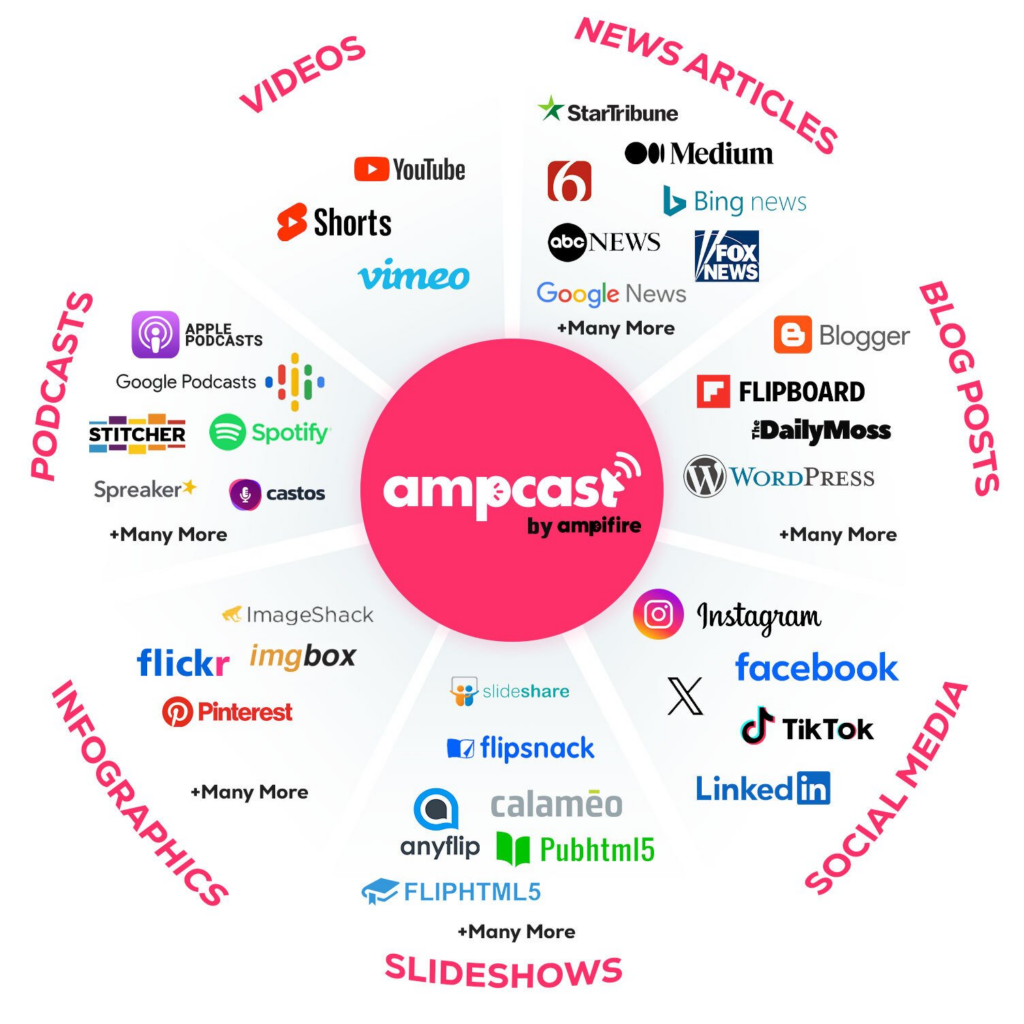Key Takeaways
- Journalists receive hundreds of press releases daily, so newsworthiness, compelling headlines, and targeted personalization are essential to stand out and secure coverage.
- Thursday is the optimal day to distribute press releases, while timing your announcement to match journalists’ deadlines and editorial calendars increases pickup rates.
- Building genuine relationships with journalists through social media engagement and respectful follow-ups generates better long-term results than one-time mass distributions.
- Traditional press releases create temporary visibility spikes, but AmpiFire’s multi-format content distribution across 300+ platforms generates sustained organic traffic that compounds over time.
What Makes a Press Release Actually Get Picked Up?
Getting your press release noticed starts with understanding what journalists care about. Your release needs to offer something genuinely newsworthy: fresh data, exclusive announcements, expert insights, or timely commentary on current events.
Your headline is everything. Think of it as your one shot to stop a journalist mid-scroll. It should be clear, specific, and compelling without resorting to hype or clickbait. The opening paragraph needs to answer the who, what, when, where, why, and how immediately.
Keep your press release concise, ideally one page or 300–500 words. Write in a journalistic style, not marketing language. Avoid jargon and sales pitches. Include verified facts, credible quotes from executives or experts, and supporting statistics. Below, we discuss strategies to increase the likelihood that your releases are picked up.
Why Press Releases Don’t Work Anymore
Smart Businesses Are Moving Beyond Traditional PR
• The Problem: Press releases reach one audience through one channel while your customers are everywhere online. Most get buried within days with poor ROI.
• The Solution: AmpiFire’s AmpCast creates 8 different content formats from one topic and distributes across 300+ high-authority sites including Fox affiliates, Spotify, and YouTube.
What You’ll Learn on PR Zen:
✓ Why multi-channel content delivers 10x better results than press releases
✓ How to amplify your PR efforts across multiple platforms
✓ Real case studies of businesses dominating search, social, video, and podcasts
✓ Cost-effective alternative to expensive PR agencies
Ready to Replace Press Releases? Learn the AmpiFire Method →
Strategies to Get Press Releases Picked Up
1. Build a Targeted Media List

Generic mass distribution is where most press releases go to die. Instead, invest time in building a targeted media list of journalists, bloggers, and editors who actually cover your industry or topic.
Research journalists who have written similar stories recently. Check their beat, read their recent articles, and understand what angles interest them. Organize your list by media type (print, online, broadcast), geography, and specialization. This allows you to personalize your pitch for different segments.
Personalization makes all the difference. Reference a journalist’s previous story in your pitch or explain why your announcement specifically fits their beat. This shows you’ve done your homework and aren’t just sending the same generic message to everyone. Keep your media list updated; journalists frequently change beats and outlets, so outdated contact information wastes your time.
2. Timing & Distribution
When and how you distribute your press release significantly impacts pickup rates. Thursday is the best day to send press releases, giving journalists time to review and publish before the week ends. Avoid Mondays when inboxes are overflowing from the weekend, and skip Fridays when newsrooms are winding down.
Consider your distribution approach carefully:
Newswire services like PR Newswire offer a broad reach but can be expensive and impersonal. They work best for major announcements requiring mass exposure, but don’t expect high engagement rates. Direct personalized emails to your curated media list generate much better results. A thoughtful, tailored pitch to the right journalist outperforms 100 generic mass emails.
Your owned channels matter too. Publish the press release on your website’s newsroom and share across social media platforms like LinkedIn and Twitter. This creates additional visibility and helps journalists who follow you find the announcement.
Match your timing to journalists’ schedules. Morning distributions typically perform better than afternoon sends. Consider the news cycle in your industry and avoid sending during major breaking news when your story will get buried.
3. Make It Easy for Journalists
Journalists appreciate it when you make their job easier. Create a comprehensive press kit that includes everything they might need:
- The press release should be in a clean, copyable text format.
- Add high-resolution images, logos, and infographics.
- Include video files or multimedia assets if relevant.
- Add clear contact information for follow-up questions.
Host these materials in an organized, easily downloadable format. Don’t embed heavy files directly in emails; provide links to a media kit or cloud storage instead. The faster a journalist can access what they need, the more likely they are to cover your story.
4. Build Real Relationships with Journalists

The brands that consistently get media pickup are those that invest in building genuine relationships with journalists over time. Engage with journalists on social media by commenting on their articles or sharing their content.
When you do reach out with a press release, follow up politely without being pushy. Respect their time and editorial independence. Never demand coverage or act entitled to their attention.
Offer exclusive angles or early access to stories for journalists you’ve built relationships with. Become a reliable source of information in your industry, even when you’re not promoting something. This positions you as a valuable contact they’ll turn to when writing relevant stories.
Why Press Releases Alone Don’t Work Anymore
Here’s the reality: traditional press releases create a temporary spike in visibility that disappears within 24–48 hours. Even if you get media coverage, it quickly gets buried in search results and social feeds. You’ve spent all that time and effort for a moment of attention that fades fast.
The media world has fundamentally changed. Your customers aren’t just reading newspapers anymore; they’re watching YouTube videos, listening to podcasts during their commute, scrolling social media, and searching Google for solutions. A press release that only lives as a news article misses 90% of where your audience actually spends time.
This is where most PR strategies fail. They focus all their energy on getting that one media mention instead of building sustained visibility across multiple channels where customers are actively looking for information.
Why AmpiFire Beats Traditional Press Release Distribution

AmpiFire solves the fundamental problem with traditional press releases: they disappear too quickly. Instead of creating content that gets buried after a day, AmpiFire transforms your announcement into eight content formats and distributes it across 300+ high-authority platforms.
Multi-Format Content That Reaches Everywhere
With AmpiFire, your single announcement becomes news articles, blog posts, long-form videos, video shorts, interview podcasts, infographics, slideshows, and social posts. This multi-format approach means your message reaches customers wherever they prefer to consume content.
Sustained Organic Traffic That Compounds
Unlike a press release that disappears in 48 hours, AmpiFire’s distribution builds traffic that grows over time. One company used AmpiFire to achieve a 1100% increase in organic traffic over 21 months with strategic content distribution. This isn’t a guaranteed result, but it demonstrates what’s possible when your brand story reaches audiences consistently across multiple channels over time.
Your content appears on Fox affiliates, NBC, Google Podcasts, Medium, SlideShare, Pinterest, YouTube, and hundreds of other trusted platforms. These aren’t just backlinks—they’re real content placements that continue generating traffic, clicks, and conversions months after publication.
No PR Team or Technical Skills Required
AmpiFire handles everything through a simple three-step system:
- Research: They study your brand, audience, and message to craft the right content strategy for your goals.
- Repurpose: The team transforms your announcement into eight unique formats optimized for each platform’s best practices.
- Distribute: Every piece gets published across hundreds of trusted platforms, creating broad exposure without you lifting a finger.
You get the visibility of a major PR campaign without hiring an expensive agency or building an in-house content team. Small businesses can compete with enterprise brands because we level the playing field.
Cost-Effectiveness That Makes Sense
Traditional PR agencies charge thousands per month with no guarantee of results, but we provide guaranteed distribution across 300+ platforms at a fraction of the cost. The ongoing content strategy creates compounding returns.
Each piece of content continues working for you long after publication, building an asset library that generates traffic 24/7. This long-term approach delivers far better ROI than one-off press releases that spike and disappear.
Frequently Asked Questions (FAQs)
What makes a press release newsworthy enough to get picked up?
A newsworthy press release offers fresh, timely information that’s relevant to a journalist’s audience. This includes original research data, expert commentary on current events, significant company milestones, exclusive announcements, or stories that impact the community.
How many journalists should I pitch my press release to?
Quality trumps quantity. A targeted list of 20–50 relevant journalists who cover your industry will outperform a generic blast to 500 random contacts. Focus on building a curated list of reporters who have written similar stories, then personalize your pitch to each one. Update this list regularly as journalists change beats and publications.
Should I follow up if a journalist doesn’t respond to my press release?
Yes, but do it thoughtfully. Wait 2–3 business days, then send one polite follow-up email. Reference your original pitch, offer additional information or a different angle, and respect their time. If you still don’t hear back, move on. Aggressive or repeated follow-ups damage relationships and hurt your chances of future coverage.
How do I measure if my press release distribution was successful?
Track media pickups, social media shares, website traffic referrals, and conversion actions from press coverage. Use media monitoring tools to see where your release was published and the reach of each placement.
Beyond immediate metrics, measure long-term brand awareness growth, improvements in search results for your brand name, and whether the coverage generated qualified leads or sales inquiries.
How does AmpiFire’s approach differ from traditional press release distribution?
Traditional press release distribution sends a single format (a text article) to journalists, hoping they’ll cover it, with results that fade in days. AmpiFire creates eight different content formats from your announcement and guarantees distribution across 300+ platforms, including Fox affiliates, Spotify, YouTube, and major blogs.
Instead of hoping for media pickup, you get guaranteed placements that generate sustained organic traffic from search, video, podcasts, and social media for months, all without needing an in-house PR or content team.

